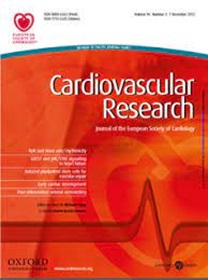缺铁性贫血对妊娠自发性高血压大鼠母体血流动力学和心功能的影响
IF 13.3
1区 医学
Q1 CARDIAC & CARDIOVASCULAR SYSTEMS
引用次数: 0
摘要
目的妊娠期高血压疾病(HDP)的特点是产妇心血管适应不良或不充分,并与不良的围产期结局相关。缺铁(ID)是一种常见的妊娠并发症,引起许多心血管适应。虽然通常认为妊娠期服用维生素d是有害的,但目前尚未研究维生素d是否会减轻或加剧HDP孕妇的心血管功能障碍。方法与结果将自发性高血压大鼠(SHR)和正常Wistar Kyoto大鼠(WKY)在妊娠前和妊娠期间分别饲喂补铁和限铁饮食。妊娠母鼠在妊娠期间接受尾袖容积描记和超声心动图检查,并在GD21(足月=GD22)时进行压力-容积环评估和体内血压(BP)测量。数据采用Holm-Šídák事后检验的2-Way方差分析。饮食铁限制导致妊娠期间血压逐渐降低,在SHR母鼠中最为明显。到GD21时,所有的ID胎儿都有中度贫血,而两种菌株的ID胎儿都表现出严重贫血、不对称生长受限和胎盘肿大的迹象。在这两个品系中,母体ID与左心室重构有关,尽管循环NT-proBNP水平(病理拉伸的标志)在ID- shr母系中降低。母体ID心脏表现出增强的心室功能,这反映在相对于富含铁的心脏增加的搏量和心输出量上。ID还提高了心脏效率和心室-动脉耦合,后者的效果在SHR大坝中最为明显。结论:与正常血压的WKY鼠相比,妊娠期的ID与SHR鼠的血压降低和心脏功能改善有关,尽管两种品系的ID胎儿均表现出生长受限和胎盘肥大。这些发现强调了妊娠期既存高血压与ID性贫血之间复杂的相互作用,如果转化为人类,可能对这两种普遍健康状况的识别和管理具有重要意义。本文章由计算机程序翻译,如有差异,请以英文原文为准。
Effects of iron deficiency anemia on maternal hemodynamics and cardiac function in pregnant spontaneously hypertensive rats
Aim Hypertensive disorders of pregnancy (HDP) are characterized by adverse or inadequate maternal cardiovascular adaptations and are associated with poor perinatal outcomes. Iron deficiency (ID) is a common pregnancy complication that elicits numerous cardiovascular adaptations. Though generally considered deleterious in pregnancy, whether ID mitigates or exacerbates maternal cardiovascular dysfunction in HDP has not been investigated. Methods and Results Pregnant spontaneously hypertensive rats (SHR) and normotensive Wistar Kyoto (WKY) rats were fed either an iron-replete or an iron-restricted diet prior to and throughout pregnancy. Pregnant dams underwent tail-cuff plethysmography and echocardiography throughout pregnancy, as well as pressure-volume loop assessments and in-vivo blood pressure (BP) measurements on GD21 (term=GD22). Data were analyzed by 2-Way ANOVA with Holm-Šídák's post-hoc test. Dietary iron restriction caused progressive BP lowering throughout gestation that was most apparent in SHR dams. By GD21, all ID dams had moderate anemia, whereas ID fetuses of both strains exhibited signs of severe anemia, asymmetric growth restriction, and placentomegaly. Maternal ID was associated with left ventricular remodeling in both strains, albeit circulating NT-proBNP levels—a marker of pathological stretch—were reduced in ID-SHR dams. Maternal ID hearts exhibited enhanced ventricular performance reflected by increased stroke volume and cardiac output relative to their iron-replete counterparts. ID also improved cardiac efficiency and ventriculo-arterial coupling, and these latter effects were most pronounced in SHR dams. Conclusions ID in pregnancy was associated with greater BP lowering and improved cardiac performance in SHR dams compared to normotensive WKY dams, albeit ID fetuses from both strains exhibited growth restriction and placentomegaly. These findings highlight a complex interaction between ID anemia in pre-existing hypertension in pregnancy, and if translated to humans, could have important implications for the identification and management of both prevalent health conditions.
求助全文
通过发布文献求助,成功后即可免费获取论文全文。
去求助
来源期刊

Cardiovascular Research
医学-心血管系统
CiteScore
21.50
自引率
3.70%
发文量
547
审稿时长
1 months
期刊介绍:
Cardiovascular Research
Journal Overview:
International journal of the European Society of Cardiology
Focuses on basic and translational research in cardiology and cardiovascular biology
Aims to enhance insight into cardiovascular disease mechanisms and innovation prospects
Submission Criteria:
Welcomes papers covering molecular, sub-cellular, cellular, organ, and organism levels
Accepts clinical proof-of-concept and translational studies
Manuscripts expected to provide significant contribution to cardiovascular biology and diseases
 求助内容:
求助内容: 应助结果提醒方式:
应助结果提醒方式:


